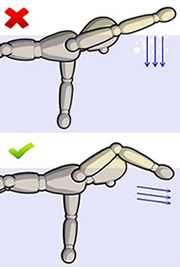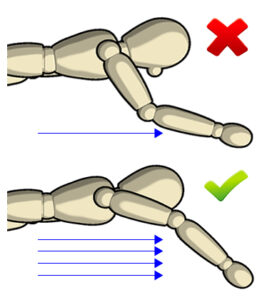I recently asked the My Triathlon Swim community to share their biggest challenge, when it comes to swimming freestyle. I received some great responses. (A BIG thank you to everyone who replied.)
Many of the usual suspects were represented in the feedback….
“I swallow water when I breathe…”
“My legs sink!”
But several members of the community listed injuries as their biggest challenge. This isn’t really a surprise, since swimming can be brutal on upper body joints, especially the shoulders.
There are a couple of common stroke-related factors that can contribute to shoulder injuries. One causes shoulder injuries when preforming an incorrect stroke technique, while the other causes injury when attempting a correct stroke technique.
Here’s what I mean….

Figure 1
Incorrect Hand Entry: Through, Not Over
As your hand enters the water your goal is to reach through the water to around 12-inches below the surface. (See the lower half of Figure 1.) You’re reaching and gliding, in search of stable water in which to “anchor” your hand.
Instead of reaching through the water, many swimmers reach over the water. (See the upper half of Figure 1.)
This creates three issues:
- Brings air down into the catch zone.
- Forces the swimmer to start pulling immediately, without gliding and finding stable water.
- Places a tremendous amount of stress on the shoulder joint.
If you suffer from shoulder pain when you swim, take a look at how your hand enters the water. Is your arm already straight when your hand enters? Do you see a big pool of bubbles where your hand entered? If so, consider entering with a bent arm and reaching through the water. Then glide.
Correct Catch: Strength and Flexibility is Key
Once you’ve reached through the water, glided on your lead hand, and found that stable water, it’s time to start your pull.

Figure 2
The correct technique here is to keep a high elbow and make a “paddle” with your hand and forearm, as illustrated in the lower half of Figure 2. Many swimmers drop their elbow and “slip” the water. (See the upper half of Figure 2.)
Performing a high-elbow catch is the most advanced skill we discuss on this beginner site. You can read more about the correct catch technique in the guide, plus get workouts in the workout section.
A high-elbow catch requires strength and flexibility. For that reason, it’s important to stretch and strengthen your shoulder joints, using dry land exercises.
If you’re looking for a good way to strengthen your shoulders for swimming, consider getting a set of StretchCordz. I often encourage swimmers to keep a set at the office or home and do a few sets each day. You’ll be surprised how quickly you see a difference in your stroke.
I hope these stroke tips help with any shoulder injuries. However, stroke adjustments might not be the fix for your shoulder issues. I encourage you to see a medical professional if shoulder pain persists.
